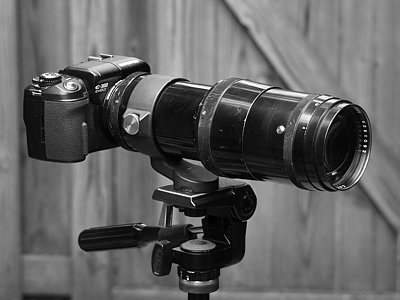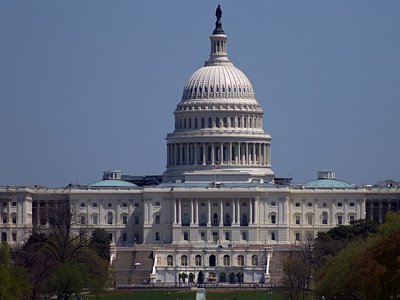One of the most acclaimed features of digital SLRs accepting interchangeable lenses is their capability to use legacy lenses from 35-mm film cameras. Digital models by Canon, Nikon, Minolta, and Pentax have lens mounts allowing for use of these legacy lenses directly (with full or partial autofocus and/or autoexposure compatibility), to persuade users who invested into such lenses to stick with the same camera brand.
Olympus chose somewhat different road: the mount in their E-System cameras (E-1, E-300) is not directly compatible with any pre-existing Olympus lenses (OM Zuiko), but allows to mount them with use of a special adapter.
Being able to use all those lenses should be a good thing, right? To some extent, yes, but not without various ifs and buts.
Image size
Most of the differences in the behavior of a lens when mounted on two different cameras are due to the fact that the digital camera sensor is usually smaller than the 35-mm film frame (except for a few professional digital SLRs, priced accordingly, which use 24x36 mm sensors).
Thus, the Olympus E-System cameras use the Four Thirds sensor size, with the image being 13x17.3 mm. Neglecting the difference in image aspect ratio (proportions), this means that the image is, in linear terms, about two times smaller than that of the 35-mm film. Digital SLRs from other makers use sensors sized similarly to the ill-fated Kodak APS system. While the sensor size varies slightly between makers and even models, it is usually 1.5x or 1.6x smaller than film frame: about 16x24 mm or slightly less, preserving the 3:2 ratio of the 35-mm film frame.
The focal length
The focal length (FL) of a lens does not depend on what camera it is used on. Roughly speaking, it describes where the lens will form a sharp image of an object which is placed at infinite (read: large enough) distance from the camera.
We grew accustomed to using the FL to describe the captured image angle. Short focal lengths mean wider angles; long ones — narrower. This is true, but only within the same image frame size.
If a frame size is N times smaller, the captured image angle becomes smaller too. The focal length is no longer a dependable measure of how a given object will fill the frame. Actually, the same angle will be now provided by a lens with the focal length N times shorter. If a 50 mm lens provides a "normal" angle on an Olympus OM-1, the same angle on the digital E-1 will be provided by a 25 mm lens (N=2).
To make comparisons between digital and film cameras easier, we sometimes use "35-mm equivalent focal length" (EFL); in the above example we can say that a 25 mm FL lens, regardless of for which camera it was made, provides an EFL of 50 mm.
To put it together: the EFL of a lens mounted on a digital camera is the focal length of (another) lens, which provides the same image angle on a 35-mm film model. Shortly, EFL = N*FL, where N is the linear ratio between image frame sizes, sometimes referred to as "focal length equivalence ratio".
This is good news and bad news. It means that your OM 200 mm lens, when mounted on the E-1 body, becomes equivalent to a 400 mm telephoto mounted on the OM-1; doubling your reach in wildlife applications. On the flip side, your cherished OM 24 mm wide-angle becomes a run-of the-mill standard lens on the E-1, equivalent to a 48 mm lens on the OM camera, no longer so impressive, and hardly a wide-angle.
The aperture
The lens aperture, again, is a feature of the lens itself, and it does not depend on what camera the lens is used. It defines how the illumination of the subject translates in the illumination of the image plane.
This means that your F/2.0 OM lens still remains an F/2.0 lens on the E-1, regardless of the change in the EFL (or image angle).
Lens sharpness
Here is one thing which the advocates of using film lenses on digital cameras rarely mention, if at all. The digital frame is smaller than the film one; for the same print size it requires N times more magnification in the printing stage. Any image flaws will be also enlarged N times more.
Looking at it from the opposite side, the resolution of a lens used on a digital camera needs to be twice the resolution required from a lens used on a film camera. But in case of legacy lenses, this is still the same lens, and its resolution does not miraculously change when mounted on a different body!
Every lens is a compromise in design. For example, at the same price (whatever it may be) you can make a sharper lens with smaller aperture, or a less sharp (but still "sharp enough") one with a greater aperture. You cannot have it both ways.
The key word here is what "sharp enough" means. Usually this assumes the largest print size at which the resulting unsharpness will still nor be objectionable. If your OM lens has been designed to provide good results up to 30x40 cm prints, the same lens used on the E-1 will provide equally sharp results up to 15x20 cm (N times smaller print size), period. There is now way around it.
A better lens might have been designed to be sharper than "sharp enough"; but the math stays the same. When used on a digital body it will become just "sharp enough" or less. Lens makers have no motivation to make lenses with more resolution than required by expected applications.
The rig is equivalent to a 600 mm F/4 lens used on a 35-mm camera, except that the latter would have to be stepped down to F/8 to provide the same DOF (still, shallow enough).
A real conversation item, merging two pieces of technology, half world and 50 years apart.

[1] Picture taken with an Olympus E-20. Click here for XGA version.
Depth of field
This is one of the most misunderstood aspects of comparing lenses between different systems. If we want to keep the same image angle, our digital camera should use a lens with FL being N times shorter, while the resulting image will need N times more magnification in print. On the other hand, the size of the "circle of confusion", i.e., unsharpness due to our subject not being exactly in focus, drops by a factor of N-squared. Reducing the whole lens and image size by N leads, at the same subject distance (expressed in meters, not multiples of focal length!) to an effective increase in DOF!
To save your time and our Publisher's valuable space, I'm not going to delve into details here; refer to my article at wrotniak.net if you are interested. Here is just the bottom line:
At any aperture (F-number) A, a lens of focal length F used on a camera with equivalence ratio N will provide the same depth of field as a lens of focal length N*F stepped down to aperture N*A used on a 35-mm film camera.
If this sounds dry and not very readable, I can't help it. Just re-read it (slowly) again. An example may help. If you put a 50 mm lens (regardless of what camera it was designed for) on your E-1, and use the maximum aperture of F/1.7, it will provide the same DOF as a 100 mm lens stepped down to F/3.4 on your OM-1: 3.4 is 2*1.7, and 2 is our value of N. Remember that the actual aperture, determining the exposure, is still F/1.7.
This is a good news if we want to maximize the DOF, but bad news if we want to keep it shallow for aesthetics reasons. While some film purists may say that only a full-size 24x36 mm sensor (N=1) may be suitable for serious applications just to keep the out-of-focus background where we need it, many users will be happy to see fewer badly-focused images of moving subjects shot with long lenses. I believe the Four Thirds system, with its N=2, strikes a reasonable balance here. Smaller sensors (N=4, 5, or greater is common in non-SLRs) may provide too much depth of field for some applications. Actually, we heard the same discussion when the world was moving from the 6x9 cm format to 24x36 mm.
The contrast has been increased in postprocessing (a normal need with lenses this long); the sharpness is so-so, OK for some purposes, but far from that achievable with a designed-for-digital prime lens, or even a tele zoom.
You may also have a look at the XGA version.
At least hauling this monster around keeps me trim and fit.

[2] Olympus E-300 with Zeiss Sonnar 4/300 mm.
The lens has been stopped down just a tad, to F/4.0, exposure of 1/3200 s (sic!), ISO 100.
While the contrast is quite low (verified on more frames), the sharpness is better than from the Sonnar; the lens is quite usable, but not better than my 55-200 mm Sigma AF zoom in Four Thirds mount, bought at just $160.
This image was not included in the original Quest article; here is also the XGA version.

[3] Olympus E-300 with Vivitar 3.5/200 mm.
Not just digital
All I've said above is also applicable to situations not necessarily involving digital cameras. The venerable Pen F series of film SLRs used the film frame of 18x24 mm, resulting in the equivalence ratio of 1.44 (using the frame diagonal as the image size measure).
This means, for example, that a 50 mm, F/2 lens on the Pen F would behave similarly to a 72 mm, F/2 lens mounted on an OM-1, except that it will provide a DOF like the latter lens stepped down to F/2.9.
Other issues
In this discussion I've addressed only general aspects of comparing focal lengths between various camera systems in general, and using legacy lenses on digital cameras in particular. As they say, the devil is in details, especially in the latter case. Those may deserve a separate follow-up article: lens compatibility (coupling, flange distance), possible metering and white balance problems, and more. Maybe one day. [Note for the Web version: see links below.]
In the meantime, however, if you have a legacy of OM Zuiko lenses, an E-System digital camera and a proper lens adapter (these used to be available for free from Olympus), go outside, and start shooting, if only for the fun of matching two pieces of technology 30 years apart.